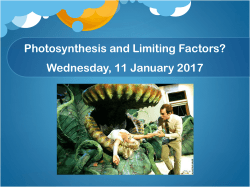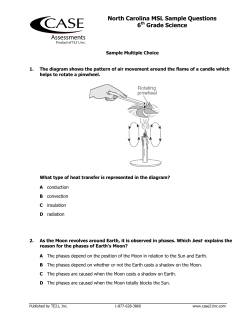
Photosynthesis & Primary Production
Photosynthesis & Primary Production What is photosynthesis? Photosynthesis Solar energy What are autotrophs? 6CO2 + 6H2O → C6H12O6 + 6O2 • Solar energy powers the reaction new organic compounds •Carbon dioxide and water used to make glucose •Oxygen gas is released as a by-product inorganic materials Fig. 4.5 Photosynthesis Fig. 4.8b What absorbs light energy? - Chloroplast contains the photosynthetic pigment chlorophyll -Absorbs mainly red and violet- Chl a absorbance blue regions of visible light Fig. 4.6 Cellular Respiration 6CO2 + 6H2O ← C6H12O6 + 6O2 Chemical energy - opposite of photosynthesis -Releases energy in glucose, organisms store in ATP molecules until use - Both autotrophs and heterotrophs respire Fig. 4.5 Primary Production (P°) - What is primary production? -Net gain in organic matter that results when autotrophs photosynthesize more than they respire, i.e., P >>> R ****Requires nutrients for organisms to grow, reproduce**** -This organic matter (new plant material) is available for heterotrophs Primary Production ‘primary’ production because photosynthesis is the basis of most marine biomass production Primary productivity is the rate of primary production, the rate at which plant material is produced Photosynthesis as a function of Light Intensity (P vs. I) Pmax Photosynthesis (P) photoinhibition Pn Pg – Gross Primary Productivity Pg Pn – Net Primary Productivity Pmax – maximal photosynthesis value Ic – compensation light intensity + Compensation point 0 respiration Ic Light intensity (I) Pmax Photosynthesis (P) photoinhibition Pn Pg + Compensation point 0 Respiration R Ic Light intensity (I) Gross photosynthesis: Total photosynthesis before subtracting respiration Net photosynthesis: Gross photosynthesis minus respiration, i.e. Pg – R Is available to support other trophic levels Compensation point: Light intensity when photosynthesis equals respiration, i.e. P=R Lower part of the photic zone Ecological Zonation of the Marine Environment Photic Zone Fig. 10.20 Photic Zone Part of the pelagic that light penetrates (0 to 100-200m) • Clarity of water: •Seasons •Location Phytoplankton carry out photosynthesis • Primary Production (Pº) is at maximum • Responsible for up to 95% of all marine primary production • start of the marine food chain Marine Organisms Grouped by Lifestyle Fig. 10.19 2 easy ways to measure primary production Either measure Oxygen (endpoint of the photosynthesis reaction) Or measure Chlorophyll a (approximates phytoplankton biomass Today’s Lab: measuring photosynthesis = Pn =R Fig. 10.15 = Pg Photosynthesis – Primary Production Experiment Purpose: To determine if more light produces more Net photosynthesis (Pn). Hypothesis: Net photosynthesis (Pn) in high light conditions will be greater than Net photosynthesis (Pn) in a low light environment. Methods Six groups of 2 people (some groups will have 3) Each group gets 2 BOD (Biological Oxygen Demand) bottles. 1 will be the LIGHT bottle and the other the DARK bottle. Three groups will keep bottles under the high light and three will put bottles in low light. Measure and record t=26 hrs oxygen concentration in mg/L. Do NOT remove foil until you take the measurement. Use the same DO meter. (t=0 was already done) Each group measure light levels in two environments Results Adjust initial and final oxygen concentrations Light levels Record light levels in high light and low light conditions for comparison Errors? Record any animals. Record bubbles in light bottle. Results Adjust initial and final oxygen concentrations Light levels Record light levels in high light and low light conditions for comparison Errors? Record any animals. Record bubbles in light bottle. Results-photosynthesis experiment Calculations Gross photosynthesis Pg = (Final O2-Initial O2) in Light Bottle – (Final O2-Initial O2) in dark bottle Incubation period Incubation period Net photosynthesis Pn= (Final O2-Initial O2) in light bottle = Pg – R Incubation period Respiration R = (Initial O2-Final O2) in dark bottle Incubation period Units Oxygen concentration: mg L-1 Incubation time: hr Pg, Pn, R: mg oxygen L-1 hr-1 Nutrient experiment Purpose: To evaluate if nutrient (nitrate) concentration has an effect on phytoplankton Hypothesis: Increased nitrogen concentration yields increased chlorophyll a production, and therefore, phytoplankton biomass What was done ahead of time: Phytoplankton culture was controlled for light and nutrients (Si and P), and added NO3 in 3 different concentrations (0, 200, and 450 mM ) We will measure chlorophyll a (fluorescence as a proxy) Methods Take bottle with phytoplankton, Filter using vacuum-filtration apparatus Place filter in tube, add methanol, agitate and crush filter with metal spatula Put in freezer (-20oC) for 5 minutes Centrifuge vial at top speed (5 minutes) Transfer supernatant to cuvette (~ 2 ml) Put cuvette in fluorometer, read fluorescence Convert to chlorophyll a (fluorometer does this) Lab Report Write up experiments: How light and nutrients affect phytoplankton production (of oxygen, of cells/biomass) Reports: double spaced, 4-5 pages, include tables and figures as needed Figures, plot light versus average Pn (remember legend), plot nutrient concentration versus chlorophyll a Remember the big picture/broader impact for discussion/introduction: how light and nutrients affect phytoplankton production in the ocean, what about nutrient limitation, light limitation changes in both over time, with nutrients in proximity to coastal zone (humans) Cloudy versus sunny days
© Copyright 2025



















